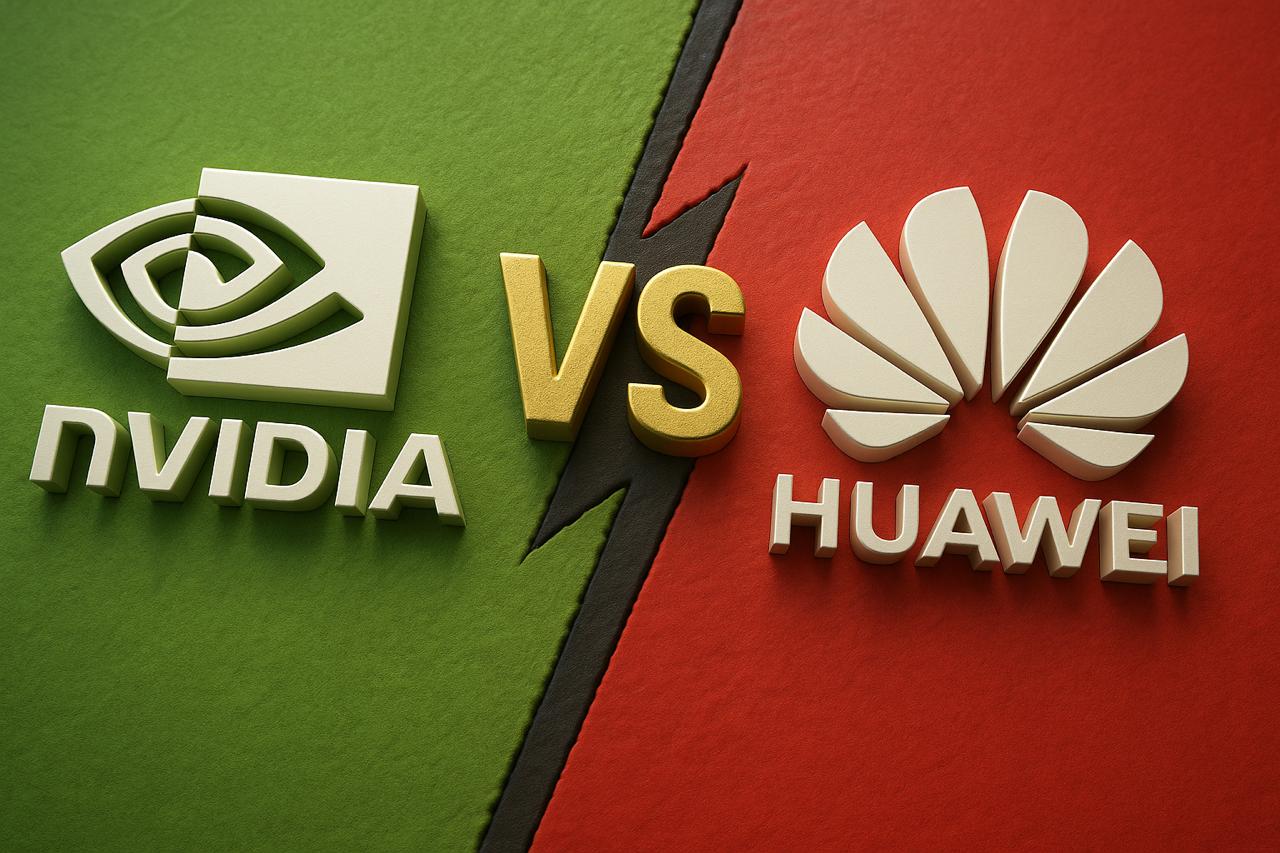Nvidia vs Huawei: New AI Chip Showdown to Cost Nvidia Billions

Trump’s Export Restrictions Spark Nvidia vs Huawei Semiconductor Battle
In early April 2025, the Trump administration extended its export controls to include Nvidia’s H20 AI training chip, effectively cutting off China’s access to one of Nvidia’s most advanced processors. The H20, launched in late 2023 to comply with previous restrictions, was tailored for large-scale AI workloads and represented a crucial revenue stream for Nvidia in the Chinese market.
After the US effectively barred Nvidia from selling AI chips to Chinese customers, Huawei unveiled its solution: the 910C AI chip, promising to fill the void left by Nvidia’s restricted hardware.
The 910C is slated for mass production as early as next month, positioning it as a domestic alternative to Nvidia’s restricted lineup. The Ascend 910C combines two 910B dies in one package and delivers approximately 60% of the Nvidia H100’s inference throughput, according to sources familiar with the benchmarks. Meanwhile, Nvidia’s H100—its flagship data-center GPU launched in March 2022—boasts advanced tensor cores and up to 80 GB of HBM3 memory, making it the industry standard for training large-language models.
With China accelerating domestic chip development to reduce reliance on US suppliers, the Ascend 910C and 920 versus Nvidia’s H20 and H100 showdown marks a pivotal moment in the global AI race. As Nvidia grapples with a projected $5.5 billion revenue hit, Huawei’s ambitious pivot underscores Beijing’s determination to achieve semiconductor self-sufficiency.
Is Huawei’s Ascend 920 AI Chip Better Than Nvidia’s H100?
Evaluating whether Huawei’s Ascend 920 outperforms Nvidia’s H100 depends on multiple factors: raw performance, software ecosystem, and production capacity. In inference tests, the Ascend 910C, Huawei’s immediate predecessor, achieved about 60 percent of the H100’s throughput, indicating that the more advanced 920 could reach between 70 percent and 80 percent under similar workloads. Build metrics suggest the 920 will offer up to 900 TFLOPS of BF16 compute and 4,000 GB/s memory bandwidth—roughly matching the H100’s specifications.
However, Nvidia’s H100 benefits from a mature software stack—CUDA and TensorRT—and broad integration across AI frameworks, such as PyTorch and TensorFlow. Huawei’s MindSpore framework is improving, but still lags in community adoption and third-party support. Furthermore, production yield and efficiency at SMIC’s N+3 node remain below those of Taiwan’s TSMC, potentially limiting Huawei’s ability to meet global demand.
Where the Ascend 920 could excel is in localized Chinese deployments, where regulatory pressures and existing ecosystem partnerships give Huawei an edge. For cost-conscious domestic data centers, a slightly lower performance ratio at a significantly reduced price point may prove compelling. Ultimately, while the Ascend 920 narrows the gap, Nvidia’s H100 maintains a lead in overall performance and ecosystem maturity.
Nvidia Stock Falls in Response to China Export Controls
Following the Trump administration’s announcement extending export restrictions to the H20 chip, Nvidia’s stock experienced a sharp decline. On April 15, Nvidia reported a $5.5 billion hit to its fiscal 2025 revenue expectations, prompting a 6% drop in after-hours trading. By April 17, shares were down roughly 5 percent, reflecting investor concerns over lost Chinese sales and potential geopolitical skirmishes.
Analysts at BCA Research warn that further US-China tensions, especially over Taiwan, could exacerbate semiconductor supply chain disruptions, potentially inflicting deeper losses on Nvidia and its peers, such as TSMC. Meanwhile, US lawmakers are investigating whether Nvidia’s chips were obtained by the Chinese AI firm DeepSeek in violation of export rules, adding to regulatory uncertainty.
Despite these headwinds, Nvidia’s broader data center business remains robust, with H100 deployments continuing outside of China. Investor sentiment has partially stabilized on the hope that future relief from trade restrictions could restore Chinese revenue streams. Nevertheless, until a clear path to resumed exports emerges, Nvidia stock faces volatility tied directly to US export policy and China’s domestic chip efforts.
Conclusion
The escalating AI chip rivalry between Nvidia and Huawei reflects a broader geopolitical contest over advanced technology. With Trump-era export controls grounding Nvidia’s H20 in China, Huawei’s Ascend 920 emerges as Beijing’s champion for achieving semiconductor independence. Although performance benchmarks place the Ascend 920 behind Nvidia’s H100, aggressive pricing, localized supply chains, and government support could grant Huawei a strategic foothold domestically.
For Nvidia, the challenge lies in balancing near-term revenue losses against long-term dominance of its ecosystem. While stock dips underscore investor nervousness, the company’s global lead in software, manufacturing partners like TSMC, and diversified AI portfolio provide buffers against Chinese competition.
Looking ahead, the AI chip market is likely to bifurcate: Huawei’s Ascend series will cater to China’s vast internal market, while Nvidia’s GPUs will power international AI research and cloud services. As both firms refine next-generation architectures—Nvidia with its Blackwell platform, Huawei with advancing N+3 nodes—the true test will be who can deliver sustainable performance and supply at scale.
Ultimately, the Nvidia vs Huawei chip wars signify more than a technology battle; they represent the global intersection of innovation, trade policy, and national security. As governments recalibrate their export regimes and domestic champions emerge, the AI arms race is poised to shape the future of computing for decades to come.
About the Author: Sarah Zimmerman is a seasoned crypto and Web3 news writer passionate about uncovering the latest developments in the digital asset space. With years of hands-on experience covering blockchain innovations, cryptocurrency trends, and decentralized technologies, she strives to deliver insightful and balanced news that empowers her readers. Her work is dedicated to demystifying complex topics and keeping you informed about the ever-evolving world of technology.
Sarah Zimmerman
Published on Other News Site















